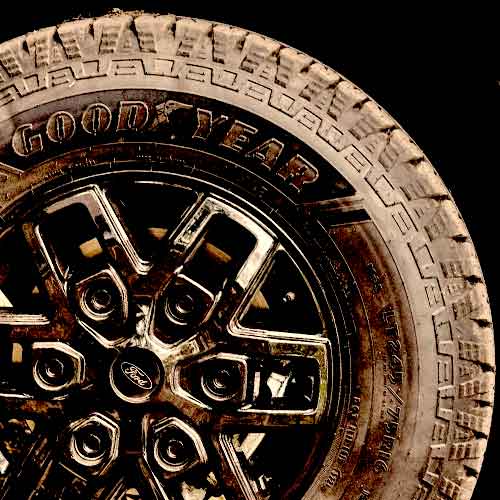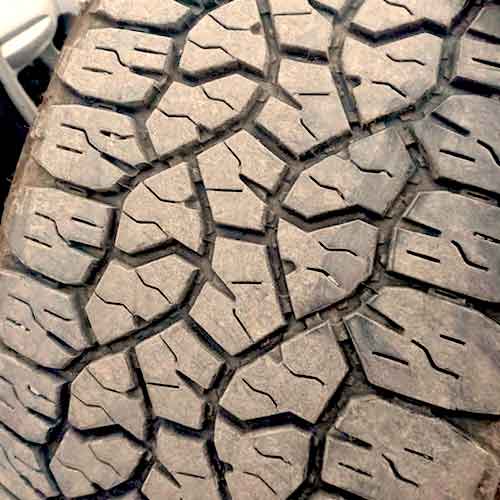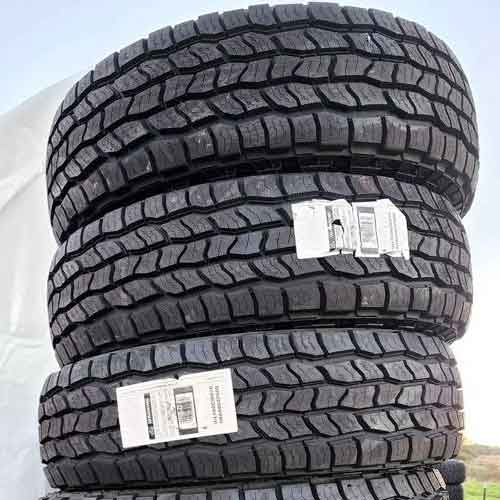Goodyear Wrangler Workhorse AT and the Cooper Discoverer AT3, both are from All-Terrain (A/T) tires category offering a superb option for many different full-sized SUVs and light pick up trucks. With 3 peak mountain snowflake rating, both offer all-season traction as well. Though both lack in a few key areas, as you’d find out soon.

Being a tire engineer, from my opinion the Goodyear Wrangler Workhorse (A/T) although severely lacks on wet roads, its dry performance is just as great, so is the overall mileage, fuel economy and snow traction, especially on ice. The Cooper Discoverer AT3 on the other side, does better in wet and off road, it’s superior on rocks and mud.
Tire Sizes
Wrangler Workhorse gives you 15 to 22 inches.
- Speed ratings available: R, S, T and some have H (much better rating in comparison).
- Load Ratings: Sizes are offered with SL, XL, D or E (only).
- Weight range: 29 to 53 lbs.
- Tread depth: 12/32″, 15/32″ (one size, LT 215/85R16 is seen with 16/32″).
- 3PMSF and M+S ratings available on all sizes.
- 50k miles
Moving towards the Cooper Discoverer AT3 XLT, this tire comes with 32 sizes in 15″ to 20″ rim sizes and they offer the following.
- They have speed ratings of either R or S.
- Load range: C to F.
- Weight range: 44 lbs to 70 lbs.
- Tread depth is seen to be either 16.5 or 17/32″ in all sizes.
- All sizes have 60k miles warranty.
- And all have similar winter ratings.
Durability
One of the most overlooked aspects of off-road tires is their sidewalls. Not only do they help keep the shape of the tire under heavy loads, they also help with uneven terrains, protecting from sharp edges and “thorns” (saying from experience).
Out of these tires, the Wrangler Workhorse has just 2 polyester and 2 steel belts without any cap ply, so although it’s sidewalls are average, its overall structure is a little weaker.
Cooper Discoverer AT3 in comparison provides a cap ply on top, which improves stability and gives slightly structural integrity.
Tread Design
The Goodyear Wrangler Workhorse A/T is a tire that has an aggressive overall design but is somewhat closed up.

The middle part have blocks that create four longitudinal channels, with the outer two being wider and the inner two, having a lot of curves and sharp edges.
All these tread blocks on the 3 ribs have a similar design, that looks like a horseshoe, with notches and 3D sipes, that go all the way deep.
The tire also includes features from the Goodyear Duratrac, such as mini tread blocks inside the grooves (known as Tractive groove technology). They basically try to keep the tread clean.
Moving towards the shoulder lugs, they carry similar features, as seen in the middle, and don’t offer a staggered pattern on the outer edges. Though they still provide stepped edges which join together, forming V shaped sidewall lugs.
Moreover, like the rest these shoulder lugs are also connected with each other with ridges placed in between them.
On the other side, the Cooper AT3 provides a more straight forward design of similar 5 rib structure.

Although, the tire does not offers a lot of biters like the Wrangler Workhorse, it does feature a slightly more breathable tread, allowing it to have better self cleaning abilities.
Each rib has “block pairs”, that are connected to each other with tire bars underneath, providing reinforced support and enhanced traction, especially on roads.
These blocks are also fitted with 3D full depth sipes, which feature interlock technology (as so they are much more efficient in wet, as you’ll find out shortly).
The outer two circumferential channels are wider and surrounded by snow vices from each side (saw-tooth edges on surrounding lugs).
Lastly, the shoulder lugs are staggered and form thicker sidewall lugs in comparison.
Basically out of all variants, the AT3 4S, the LT, and XLT, only the XLT has the thicker sidewalls of all.
Traction on Roads
A/T tires don’t have too much of an issue on smooth pavements, as with their excessive biters they do pretty well in handling, braking and responsiveness.
Though its only applicable to when things are dry. I’ve explained all these factors below.
Dry Grip
The footprint of a tire along with section width, are the main dimensions that affect grip, though other factors such as rolling resistance, weight, and rubber composition also contribute to it a lot.
Having said that, the Cooper AT3 having a more surface area of tread voids, is not able to offer as much directional stability, as needed, that’s why it ends up with longer braking distances and handling times.
And so you get a limited speed ratings up to only S, where Wrangler A/T provides up to H.
The Goodyear Workhorse basically offers a firmer rubber which is joined up in all directions and it’s less tread depth (across all sizes), helps it’s lugs to have better connection with the road.
Dry Handling
Handling, similar to grip, refers specifically to a tire’s performance during turns.
The weight is actually shifted towards the shoulders on corners, and tire’s sides get to be more responsible for maintaining contact with the road.
Although the Cooper AT3 has joined up shoulder lugs (with ridges in between), the Wrangler Workhorse offers less wider lateral gaps in between.
So it allows more of its shoulders to meet up with the road, producing better lateral traction in comparison.
Steering Response
A tire’s ability to communicate with the driver is a vital factor in its overall steering response.
With one extra cap ply and more weight combined with (greater) tread depth, the Cooper Discoverer AT3 offers a tread which flexes a lot more upon the surface-rubber meet up.
This means, as you try to turn the wheel, a lot of energy gets wasted in to molding the lugs, rather than moving the tire as a whole.
The Wrangler Workhorse A/T does not do that (as much). That’s because it offers a stable contact with its firmer tread composition and as its lugs provide you with a consistent contact on sides, you get to have a far quicker response without any kind of lagging.
Wet Traction
Wet performance can be divided into wet traction and hydroplaning resistance.
While all-terrain tires generally perform well in terms of hydroplaning, wet grip is slightly more challenging to achieve. So let me discuss that first.
Wet Grip
Wet roads call for tires with sipes, that are able to flex and remove water from the tire surface.
Goodyear Wrangler Workhorse A/T although offers a lot of siping, it’s tread is not at all flexible even with it’s missing cap plies.
It’s lugs are simply joined up from everywhere, with tie bars, and reinforced foundations, and it’s tread isn’t soft enough to begin with either, so sipes cant work.
Cooper Discoverer AT3 on the other side, offers better water evacuation, and its full depth interlocking sipes are better able to stretch and squeeze, to clean off water from underneath, enhancing overall wet grip by a large margin.
Hydroplaning
Hydroplaning can be prevented by ensuring that a tire has sufficient grooves to effectively evacuate water from its tread.
These grooves help the tire maintain contact with the road surface, even when moving through standing water at higher speeds.
Goodyear Wrangler Workhorse A/T doing so poorly (in overall wet traction) can be explained by this as well, let me explain.
Although its tread offers longitudinal paths with 4 aqua channels (just like it’s competitor), there isn’t any pathway for water to leave from its sides, and this lowers the curved aquaplaning (which tells how fast a tire can move on turns, on standing water).
On the other side, the Cooper AT3 has both longitudinal and lateral gaps in it’s grooves, so water is better able to leave out in multiple directions. Moreover, with more tread depth, more volume of water is able to escape in time.
Fuel Consumption
The fuel efficiency of a tire is affected by its rolling resistance, which can be influenced by the tire’s weight and tread composition too.
With missing nylon cap plies on top of steel belts (in internal construction), the Goodyear Wrangler Workhorse A/T keeps its weight very light (almost as light as an average passenger tire).
So this, combined with it’s harder composition (having less silica density), and closed up lugs placement, it generates less rolling resistance and so less fuel is consumed.
On the other side, the Cooper Discoverer AT3 although offers a more streamlined design, with greater weight, it simply puts more pressure on it’s lugs forcing them to rub against the road with more friction, consuming more fuel as a result.
Tread Life
Tread wear is determined by the tire’s compound, weight, rolling resistance, and tread structure.
The Cooper Discoverer AT3 although has a higher rolling resistance, it’s more tread depth takes more time to burn off comparatively.
The Goodyear Wrangler Workhorse on the other side, burns faster as it offers more biting edges and less streamlined on-road design with curves and sharp notches everywhere.
The tire also has tread depth of 13.5/32″ on average so that’s not helping it either.
That’s why it offers you with 50k miles warranty whereas the Cooper AT3 gives you 10k more.
Ride Quality
A tire’s ride quality is influenced by factors such as noise level, comfort, and its ability to absorb road impacts. I discussed all of them below.
Tread Noise
Shoulder lugs offer the most common source of tire noise, as they allow most of the air to enter the tread (and that air then hits around generated noise).
But when it comes to our boys here, with closed up pattern on both, they don’t allow much air to pass through in the first place.
The Cooper AT3 with ridges in between the lugs offers “Whisper Groove Technology”, whereas the Goodyear Wrangler Workhorse provides noise dampening by producing different pitches across the tread as air hits, (with this, different tone frequencies are generated and they cancel out each other to dampen the noise levels).
So I am going to rate both these tires equal here.
Comfort
Thicker tires may offer more comfort due to their ability to absorb greater road bumps, and this thickness comes from tread depth and internal construction, though their composition also affects a lot as some tread structures are stiffer then others.
Goodyear Wrangler Workhorse A/T with no cap plies in it’s internal construction although offers a softer structure, its rubber on top is still stiffer in comparison.
The Cooper AT3 that’s why does better. Moreover, with thicker tread depth it allows more room for imperfections of the road to get settled down.
Winter Traction
A tire’s performance in snowy conditions is evaluated, based on its “ability” to provide stability while stopping, maintain control during turns, and accelerate effectively on shallow and deep snow, as well as on ice.
Goodyear Wrangler Workhorse A/T is pretty great when it comes to hard packed snow, and even ice, that’s because it’s biters and siping, where it lacked so much on wet asphalts, are basically better designed for snow grabbing.
The Cooper AT3 on the other side, although is also branded with 3 peak mountain snowflake rating (just like the Workhorse), it lacks in overall biters.
Though you still get snow vices on the outer longitudinal grooves (from lugs on both sides).
Off Road Traction
Off road, there are a lot of land variations, and each require tires to have different skills. Let’s check out all of them.
On Mud
Mud is pretty challenging, and its the only reason, why M/T tires are named after it (though they are also much more capable of crawling on other terrain types as well).
But how do they do it? Well, because of their high tread void ratio. They are pretty bald, in other words.
And having said that, it makes sense why Cooper AT3 even with its “on-road design” does a better job at escaping thick mud out.
The Goodyear Wrangler Workhorse A/T, in comparison, basically is pretty closed up, and with tie bars/connectors everywhere, mud has no where to go, so it lacks a lot on this terrain.
On Rocks
Durability and traction biters are critical factors for successful performance on rocky surfaces.
So overall, although both offer 2 ply sides, with nylon cap ply the Cooper AT3 offers a more sturdy built. Moreover, it’s sidewall lugs also protect the bead area in a better way.
With lowered air pressure, they also offers superior lateral grip as well.
Goodyear Wrangler Workhorse A/T on the other side, is also not too far off. Even though its lugs are packed up, they are equipped with a lot of biters.
With all it’s 5 ribs containing “horse shoe” shaped lugs, with full depth notches and sharp sides, it’s able to grip in all directions.
Though it could have used some lugs on sidewalls, which would have made it’s lateral traction component a little better.
On Sand
On sand you always lower the air pressure of the tire, that’s almost a rule. You basically do that to make your tire “floating”.
And there are some tire features that really help that, for example weight, and tread structure.
That’s why the Goodyear Wrangler Workhorse A/T provides better capability overall. This tire is actually very light in weight, as its weight goes up to only 50 lbs.
The Cooper Discoverer AT3 on the other side, with 20 pounds heavier construction and sharp staggered shoulders on sides does not offer as much of a forward momentum as needed.
On Gravel and Dirt
Although both tires are missing proper “conventional” stone ejectors, at least Cooper AT3 provides you with ledges placements in the grooves, that keep a lot of sharp stones out.
Goodyear Wrangler Workhorse A/T on the other side is packed up, and even with it’s multiple ridges embedded in the grooves, it can’t offer as much of a self cleaning tread as its competitor.
Leave With This
Goodyear Wrangler Workhorse A/T is one of the lightest all-terrain tires that you can get, as it’s weight is almost as much as an average passenger tire.
So this, combined with biters, its able to provide you with amazing climbing abilities on rocks and sand, though its lateral traction need help (but only off-road).
On road, it’s pretty great, in dry traction, fuel economy and noise.
Cooper AT3 on the other side, is great on both wet and dry on roads, and off-road it gives you superior biting power in all directions including “laterally” where its competitor lacks.
I had the Coopers on my Tahoe, and they were loud. The ride was terrible. Even though I had them rotated like clockwork, they cupped so badly that they would throw the car all over the road. They didn’t last one full year. On the other hand, the Goodyear tires lasted 2 years, never cupped, and rode smoothly. They were twice the tire the Coopers were. I’m not biased towards any tire manufacturer; this is a real review from the real world. Don’t waste your money on Cooper. Fact.
Thank you for sharing your experience with both tires, its a valuable feedback. And it’s unfortunate to hear about the issues you encountered with the Coopers, especially since many factors can influence a tire’s performance, such as speed rating, load rating, SUV make, model, variant, and so on.
Also…I’m glad to hear that the Goodyears worked well for you.